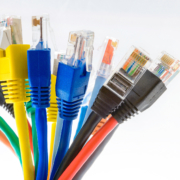Cat7 ethernet cables
What is CAT7 Ethernet cable?
As you may already know, ethernet cables come in all different shapes and sizes. These cables are categorised as Cat5, Cat5e, Cat6, Cat6a, Cat7 and Cat 8. Although these cables perform similar task the main differences between them are speed, shielding against exterior noise and crosstalk. The cable you choose for your business highly depends on the requirements. If your daily tasks require a high-power network with high speeds, Cat5/5e would not be suitable for your needs. In this article we focus on the frequently asked questions about Cat7 ethernet cables.
Category 7 ethernet cable (known as Cat7) is an advanced data cabling solution. Cat7 ethernet cables are backward compatible with Cat5e, Cat6 and Cat 6a. The cable has four twisted copper wire pairs which are shielded individually, the cable as a whole is also shielded. This shielding minimised crosstalk and system noise.
Cat7 Cable speed
Cat7 ethernet cable were designed to support 10 Gbps over up to 100 metres, certain test results have shown higher capabilities of 40 Gbps and 100 Gbps. 100 GB capabilities were tested over 15 metres. To achieve this, an exact setup of synchronized hardware will be required. Its important for us to note that these are results generated from lab tests, they’re not standards set by the cabling standard authorities.
A Cat 7 cable offers a bandwidth performance of up to 600MHz. Cat7a performances are up to 1000MHz. In comparison to previous categories the bandwidth of Cat7 is six times higher than Cat5e cabling (100mhz) and 2.4 times higher than (250mhz) of a Cat6 cable. With this in mind Cat7 is a only a slight increase from the (500mhz) of a Cat6a cable. However, Cat7a is double the performance speed of Cat6a.
What is the Cat7 Maximum length
Category 7 cables are standardised at a permanent length of 90 metres, this is the same as all previous categories however, there is an allowance of 5 metre patch leads at each end. Also available is a direct link of 100 metres. If you wish to extend beyond these distances the performance of the cable is unknown. The maximum length of the cables should be taken into consideration during the design and planning stages.
What is a Cat7 Connector
Similar to connectors from previous categories, a cat7 connector is almost identical. The RJ45 plug connector used on previous data cables is still present, there are some additional connection points within the termination connector. The added connectors are known as GG45 or TERA connectors. The changes are mirrored whether they are within a termination jack/modules, a Cat 7 patch cable, or a termination plug. The hardware transmitting and receiving data must be compatible with these additional termination points.
Is Cat7 Backwards compatible?
As previously stated Cat7 connectors are very similar to those from previous categories. Cat 7 cables have an RJ45 central connector which is the same as Cat5e, Cat and Cat6a. Because of this Cat7 cables will plug into previous systems, making them backwards compatible. The reverse is also a possibility, but then again, a cabling system is only as good as its weakest point. Therefore, if you wish to combine systems, the performance will only be as good as the lowest category within the link. For example, if you plugged a Cat7 patch lead into a Cat5e system the performance will remain at Cat5e speed.
What’s the difference between Cat7 and Cat 8
Cat7 and Cat 8 cables are constructed with the same shielding designed to reduce cross talk and exterior noise therefore providing a higher performance speed for ethernet communication.
Bandwidth – Cat7 is 600MHz, Cat7a is 1000MHz and Cat8 is rated at 2000MHz.
Cat7 ethernet cable length is 100 metres with up to 10GBps in speed. The maximum length of Cat8 cable is restricted to 30 metres with up to 25GBps or 40GBps.
So, is Cat8 the best cable? Well, the answer depends on your requirements. The main factors to consider are cable length, frequency, and speed. The decision should take into consideration the specifications of your home or business.





